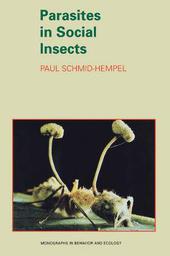
|
Parasites in Social Insects
Paperback / softback
Main Details
| Title |
Parasites in Social Insects
|
| Authors and Contributors |
By (author) Paul Schmid-Hempel
|
| Series | Monographs in Behavior and Ecology |
|---|
| Physical Properties |
| Format:Paperback / softback | | Pages:392 | | Dimensions(mm): Height 254,Width 197 |
|
| Category/Genre | Insects |
|---|
| ISBN/Barcode |
9780691059242
|
| Classifications | Dewey:595.7 |
|---|
| Audience | | Professional & Vocational | | Tertiary Education (US: College) | |
|---|
| Illustrations |
8 halftones 67 line drawings 34 tables
|
|
Publishing Details |
| Publisher |
Princeton University Press
|
| Imprint |
Princeton University Press
|
| Publication Date |
22 November 1998 |
| Publication Country |
United States
|
Description
This volume analyzes how parasites shape the biology of social insects: the ants, wasps, bees and termites. Paul Schmid-Hempel provides an overview of existing knowledge of parasites in social insects. Ideas are evaluated using a broad data base, and the role of parasites for the evolution and maintenance of the social organization and biology of insects is scrutinized. In addition the author develops insights, especially in his examination of the intricate relationships between parasites and their social hosts by a rigorous use of evolutionary and ecological concepts. Schmid-Hempel identifies gaps in our knowledge about parasites in social insects and uses models to develop new questions for future research. In addition, issues that are usually considered apart from each other - such as division of labour, genetics, immunology, or epidemiology - are placed in a common framework to analyze two of the most successful adaptations of life parasitism and sociality. This work should appeal not only to practioners in the field of behavioural ecology and sociobiology, but also to others interested in host-parasite relationships of in social organisms, such as apiculturists struggling to o
Author Biography
Paul Schmid-Hempel is Professor of Experimental Ecology at ETH in Zyrich, Switzerland, and the head of a research group on the evolutionary ecology of host-parasite interactions.
|